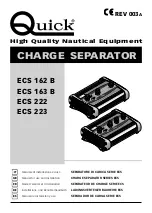
19
Pressurized sand filter
1.
Installing and operating the pressurized sand filter
1.1. Operation
A suction is taken from the main drains on the bottom of the aquarium and fed via separate pipework
through the pump to the sand filter. After filtration, the water is returned to the aquarium by the intake
valve. Once in the filter, the water is circulated downwards through silicone sand and suspended particles
are retained.
The filter sand needs to be washed regularly to remove the particles it has retained. This is achieved by
reversing the flow through the filter and directing the water containing the particles to drain. Bearing these
principles in mind, the following installation and operating instructions should not be a problem.
1.2. Installation
The filter should be installed as close as possible to the aquarium, preferably at a level of 50 cm below the
water surface. Make sure there is a drain available at the place where the filter is to be installed.
Important:
Do not use an iron tube for the selector valve connection. It is essential to use plastic
accessories and Teflon tape. Tube connections are available either threaded or for solvent fixing in
1 ½” and 2” sizes. Please ask your dealer.
2.
Sand load
In order to obtain maximum efficiency from your filter, it should be filled with silicone sand with a grain size
of 0.5 to 0.7 mm with the quantity indicated on the plate specifying the characteristics. Proceed as
following:
1.
Only fill the filter up when it is installed in the correct position and the connecting tubes have been
joined.
2.
Take off the lid and joint.
3.
Pour the required quantity of sand inside the filter.
4.
Clean the upper edge.
5.
Fix the filter in place.
3.
Operation
When the filter has been loaded, the sand must be washed, so proceed as follows:
1.
Turn the selector switch to “wash”.
2.
Open the valves controlling the suction tubes and let the pump run for 4 minutes.
3.
Stop the pump and turn the selector switch to “filtration”.
When this has been done, the filter will be ready to start the filtering cycles.
Important: The pump should be switched off when the position of the selector switch is changed.
4.
Filtration
When the pump is switched off, turn the selector switch to “filtration”. Switch on the pump. During this
process, you should observe the pressure gauge from time to time as this indicates the degree of saturation
of the filter. When the pressure reaches 18,5 PSI, “wash” should be carried out. The valves at the bottom of
the tank will be regulated according to the pollution.
5.
Backwash
Each load of sand forms thousands of channels which pick up all the material contained and caught up in
the filtering process. The number of free channels allowing the water to pass through is continually
decreasing. This is why the pressure rises progressively until it reaches 1.3 kg/cm. At this pressure, the
filtering sand is unable to collect any more impurities and has to be cleaned as follows:
Turn the selector switch to “wash”, turn the pump on for 2 minutes and leave the catch basin and return
valves open. By this method, all the dirt blocking the filter will be drained away.


































